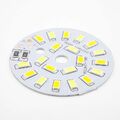Analysis of the advantages and disadvantages of cob light source and precautions for use

LED displays, decorative LED lights and LED car lights are everywhere on the streets. LED lights can be seen everywhere, and LEDs have been integrated into every corner of life. LEDs are available in discrete and integrated packages. LED discrete devices belong to traditional packaging and are widely used in various related fields. After more than 40 years of development, a series of mainstream product forms have been formed. The traditional LED method for LED production equipment manufacturers is: LED light source discrete device → MCPCB light source module → LED lamp, mainly due to the lack of ready-made and suitable core light source components. These components are not only labor-intensive and time-consuming, but also very expensive. .
Compared with discrete LED devices, COB light source modules can save the primary packaging cost of the LED, the manufacturing cost of the light engine module, and the cost of secondary light distribution in the application. In a lighting system with the same functions, actual calculations can reduce the cost of light sources by about 30%, which is of great significance to the application and promotion of semiconductor lighting. LED production equipment manufacturers can effectively avoid the shortcomings of discrete light source equipment combinations such as spotlights, glare, etc. through reasonable design and microlens molding; it can also add appropriate red chip combinations without significantly reducing the light source s efficiency. On the premise of longevity, the color rendering of the light source can be effectively improved.
In application, COB light source modules can make the installation and production of lighting factories easier and more convenient, and effectively reduce application costs. In production, existing process technology and equipment can fully support the mass production of high-volume COB light source modules. As the LED lighting market expands, the demand for lamps is growing rapidly. LED production equipment manufacturers can gradually form a series of mainstream COB light source modules according to the needs of different lamp applications for mass production.
Advantages and disadvantages of cob light source
The full name of COB integrated light source (Chip On Board), that is, the bare chip is pasted to the interconnection substrate through conductive or non-conductive glue, and then wire bonded to achieve its electrical connection. COB integrated light source is also called COB planar light source.
COB integrated light sources cover the silicon chip placement points with thermally conductive epoxy (usually silver-doped epoxy) on the surface of the substrate. The silicon chip is placed directly on the surface of the substrate and heat treated until the silicon chip is firmly fixed to the substrate. Wire bonding is used to establish electrical connections directly between silicon wafers and substrates. There are two main forms of bare chip technology: one is COB technology and the other is flip chip technology (Flip Chip). Chip-on-board packaging (COB), the semiconductor chip is manually mounted and installed on the printed circuit board. The electrical connection between the chip and the substrate is achieved through wire stitching, and the electrical connection between the chip and the substrate is achieved through seams. And covered with resin for reliability. Although COB integrated light source packaging is the simplest bare chip mounting technology, its packaging density is much lower than TAB and flip-chip bonding technologies.
Generally speaking, COB light sources are mainly used for indoor lighting. Its advantage is that the assembly process is relatively simple and the light panel is more uniform, but the heat dissipation effect is not as good as TOP, it can only be used in the range of 3-50 watts, and the light efficiency is worse than TOP. A little lower. The advantages of the cob plane light source are that the divergence of luminosity is large and relatively wide, and the light source area is relatively full. The disadvantage is that it consumes more power and is more cumbersome to set up.
Precautions when using COB light source
Static electricity:
This product is sensitive to static electricity, so effective protective measures must be taken when using this product. In particular, static electricity can produce high-voltage currents that exceed the product's maximum ratings, which can damage the product or cause it to fail altogether. Customers should take safety measures to prevent static electricity and power surges when using the product. Ground resistance ≤10 ohms. Using anti-static wrist straps, anti-static mats, anti-static overalls, work shoes, gloves and anti-static containers are all effective measures to prevent static electricity and surges. The soldering iron tip should be properly grounded.
Soldering: Use a soldering iron for manual soldering: It is recommended to use a soldering iron less than 20W, and the temperature of the soldering iron must be kept no higher than 300°C, and the soldering time should not exceed 3 seconds.
Cleaning: After welding, cleaning must be carried out according to the following conditions. Cleaner: Isopropyl alcohol or denatured alcohol (above 95°) Temperature: up to 50°C for 30 seconds, up to 30°C for 3 minutes Ultrasonic cleaning: up to 300W
Although LEDs can be seen everywhere in life, there are still some shortcomings in LEDs that require our designers to have more professional knowledge reserves so that they can design products that are more in line with the needs of life.





